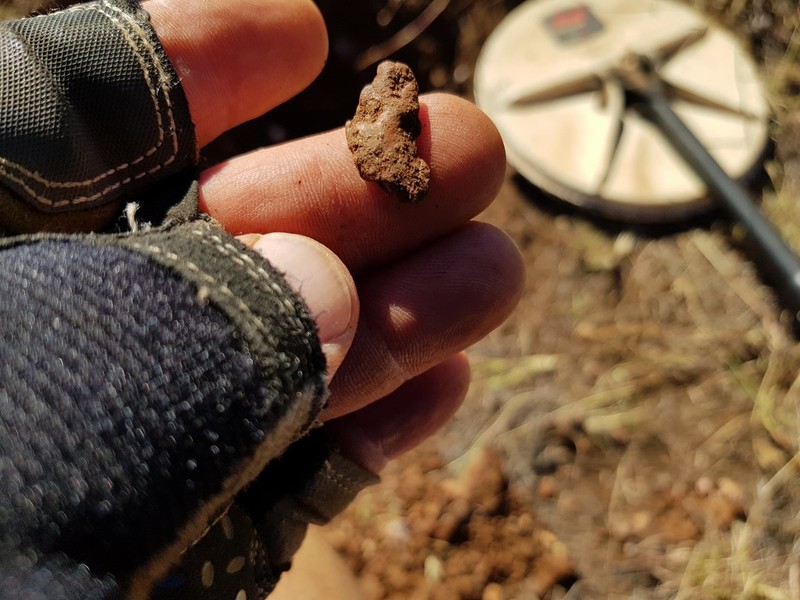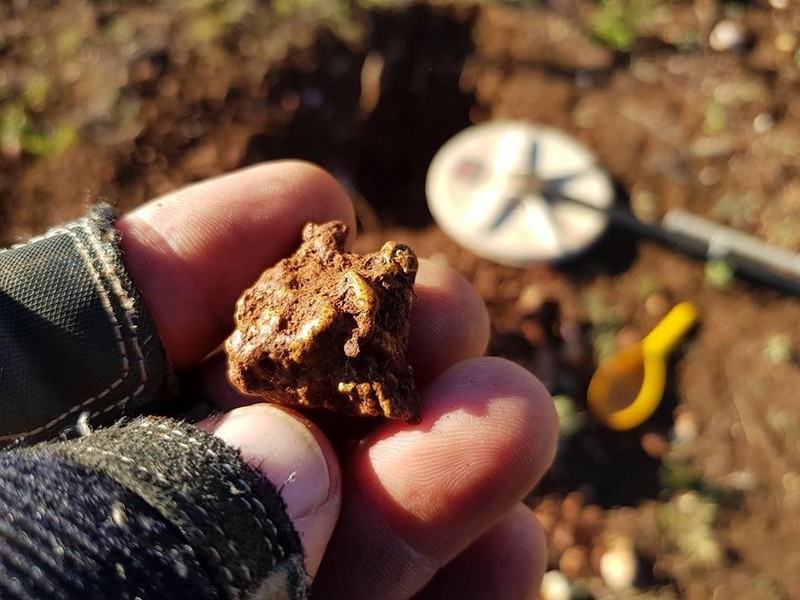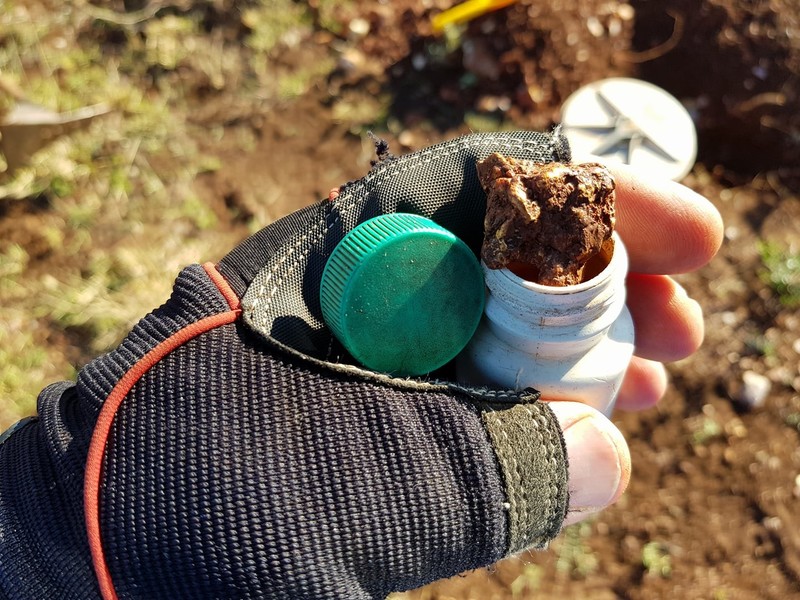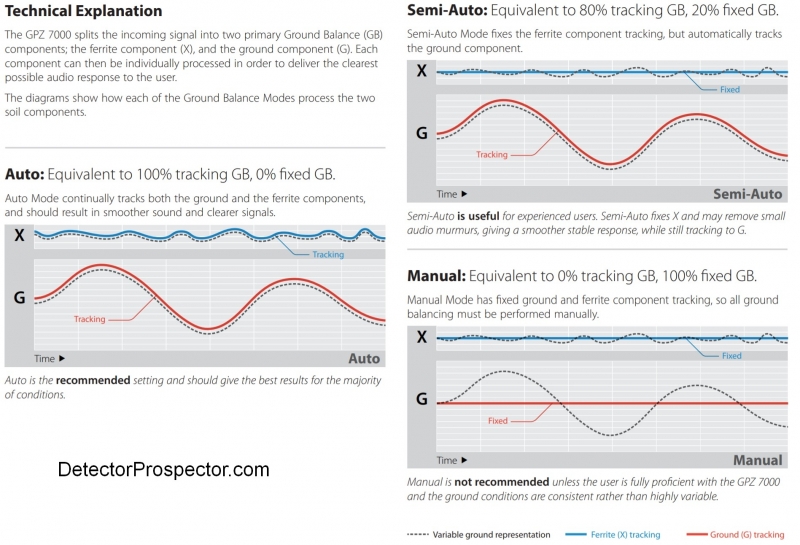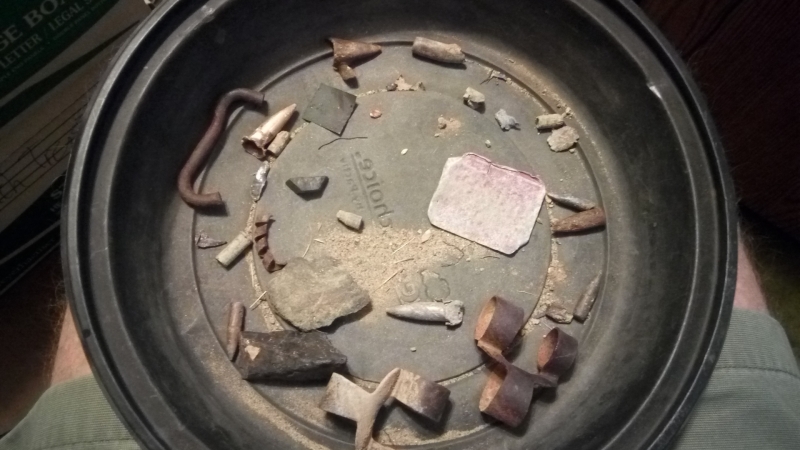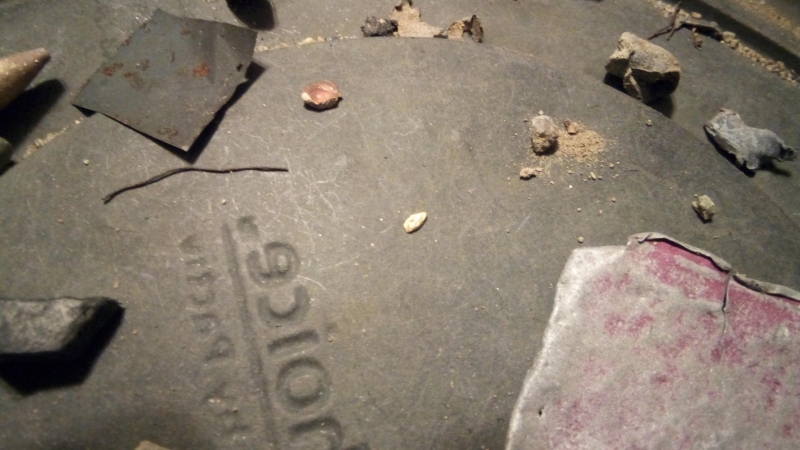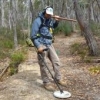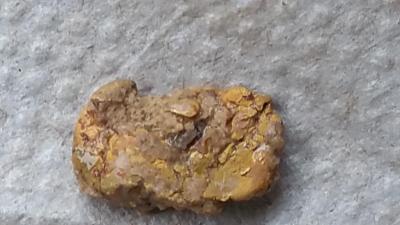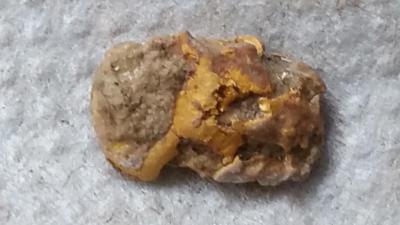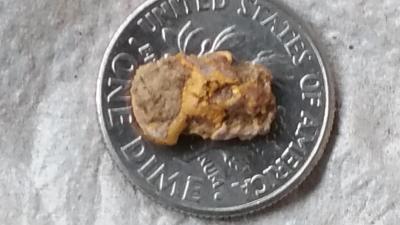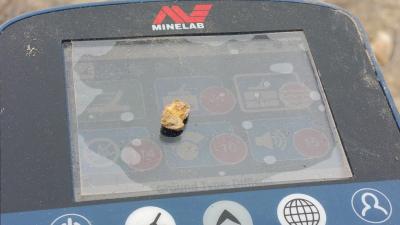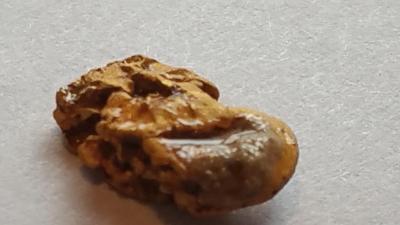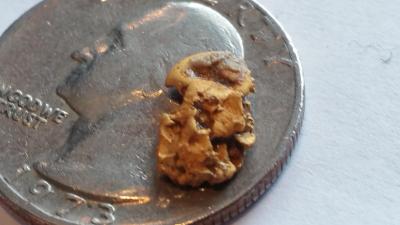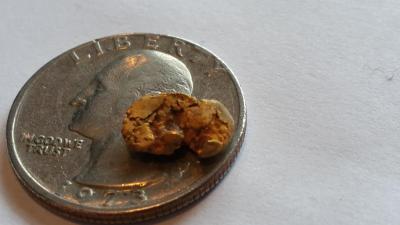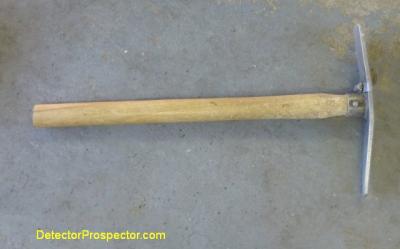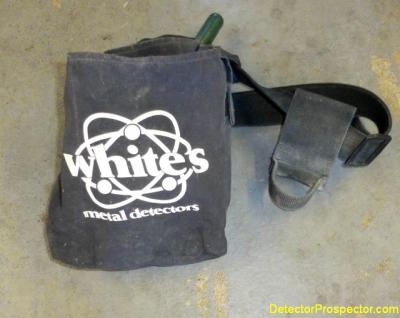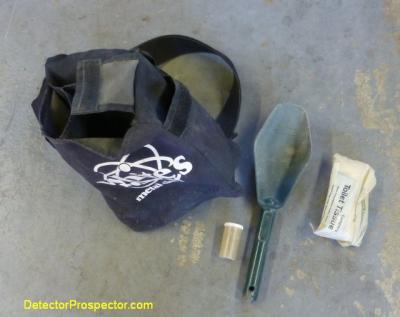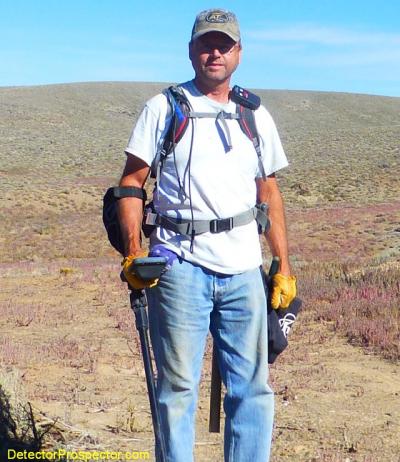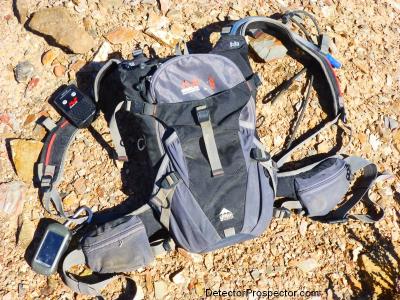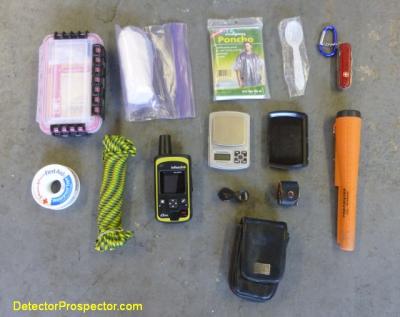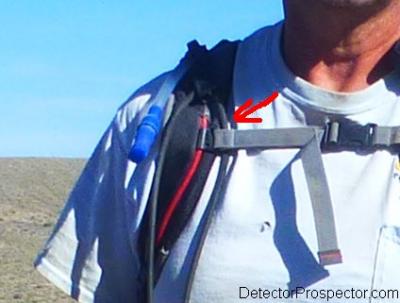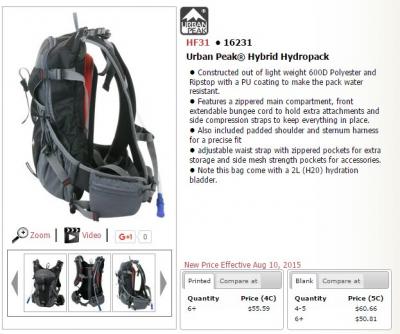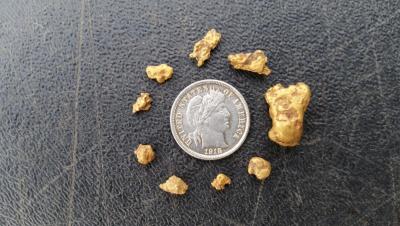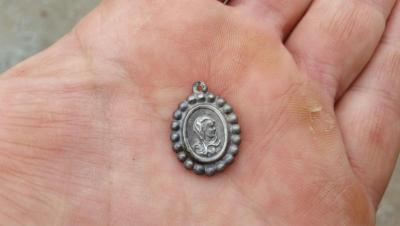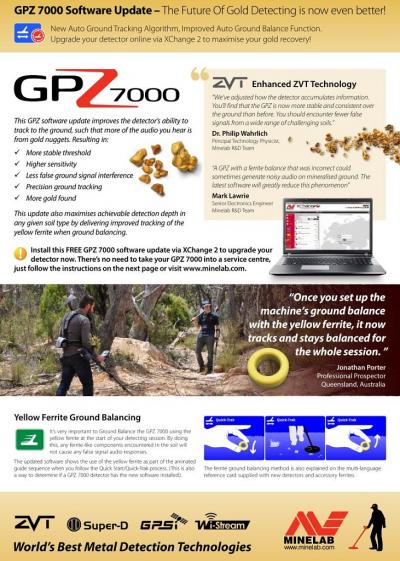Search the Community
Showing results for 'GPZ 7000 ferrite'.
-

Large Nox Coil ( Can You See Me Now? )
mn90403 replied to mn90403's topic in Metal Detecting For Jewelry
Yes, when we get all of our settings the way we like it on the 7000 we then do a noise cancel and the final ground balance is to place a ferrite ring on a typical patch of ground and swing over it. The 7000 tells us we are finished and gives us an icon to 'pick up your ring!' Someone didn't do that in this case. -

Large Nox Coil ( Can You See Me Now? )
mn90403 replied to mn90403's topic in Metal Detecting For Jewelry
The yellow thing in the scoop is a ferrite ring which we use to ground balance a GPZ 7000. When I found it out in the desert I knew I was not the first one to use this powerful detector over this hill. I was still able to find 1 half gram nugget. Mitchel -
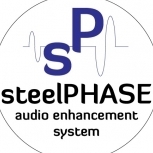
A Tiny Bit With My New Steelphase
SteelPhase replied to 1515Art's topic in Detector Prospector Forum
Nenad at Phase Technical has done a lot more testing on a 7000 than I have. Here are the settings he uses: "I do a lot of tweaking during each session but my basic go to settings are: Hot Ground: General, Difficult, Sens 6-12, Volume 9, Low Smoothing, Ground Smoothing Off Milder Ground: High Yield, Normal, Sens 6-11, Volume 8, Low or High Smoothing, Ground Smoothing Patch Locate. I nearly always use Semi Auto ground balance and just keep an eye on the ferrite balance. Also like my sP01 on Filter 2, unless on the rare occasion I may be in High Smoothing then I'll use Filter 1." -
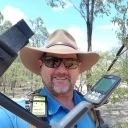
GPZ 7000 Auto, Semi Auto, Manual ???
Jonathan Porter replied to DolanDave's topic in Minelab Metal Detectors
Couple of things that need to be thought about with any auto GB but more so with the GPZ. An edge of detection target will present itself to the detectors electronics as potential ground noise so the Auto GB is going to mess with it somewhat, this is why I always move away from a potential signal response onto clean ground, center the GB under the coil, and then get the GB averaged again by carefully sweeping before moving slowly back in over the target zone. In the case of the GPZ and why you should use Semi-Auto GB over Manual (I'll discuss the differences between Auto and Semi-auto below), the GPZ has a dual receive coil design (super D or DOD as some like to call it), this coil design is difficult to make because the two receive windings have to be kept in phase, you the operator can easily throw the coil out of phase through poor coil control. Out of Phase means that one receive winding is generating a different response compared to the other. If you are working variable ground where the GB is very active the interchange between different GB scenarios can cause a tonal break in the threshold as one winding passes into the new GB scenario while the other receive winding is still in the old scenario, this interchange is heralded by a target like signal response which usually the Semi-Auto GB quickly deals with. If you are using anything less the Audio Smoothing OFF then you will generally not hear these small interchange responses as the filtering masks them along with faint edge of detection tonal target responses. If you use Manual GB those interchanges will sound very target like forcing the operator to either check them out or if the ground is really variable ignore them through attrition! Either way your technically blind while the interchange signal is in effect, using Manual the interchange response is much more aggressive and longer in duration forcing a compromised on what targets are investigated, effectively leaving quite a large amount of undetected ground. A thing to note, quite a lot of nugget signals are nested in those interchanges of mineralisation. The nugget in the FB video sounded like a broad very faint variable tonal response but experience has taught me to check these types of signals out, because I was originally in Semi-Auto GB the target response between the High/Low Low/High channels was interfering with the response, this caused the Lead In and Tail Out of the target to be extremely wide as the two channels fought each other, especially on the Tail Out (the only way I can describe this type of signal response effect is when two magnets are moved near each other with like poles, they repel each other). Setting the GB to Manual on similar ground nearby brought the target response more into the Low/High range focus allowing me to centralize the response and confirm it was indeed an edge of detection target. In this case the target turned into a deep 6 gram slug. 6 gram Nugget Dig Differences between Auto & Semi-Auto: Auto GB on the GPZ 7000 is doing 2 things at once, it is actively tracking the ground and at the same time is very slowly tracking any Ferrite like signals in the ground. Semi-Auto is only actively tracking the ground with the Ferrite balance being fixed. I do not like to use Auto in the majority of ground types in Australia as we have a lot of ground conditions that interfere with the active Ferrite balance, one is Salt and the other is Saturation. If you follow the normal Ferrite balance procedure in Auto mode and then encounter salty or saturable ground the Ferrite balance will drift away from optimum allowing Ferrite signals into the signal response (assuming there are Ferrite like signals there). These signals add to the threshold and ground noise potentially masking targets or in a worse case scenario sound like target signals that disappear. Semi Auto locks the Ferrite balance, so when you use the Quick-Trak button over the Ferrite the detector is actively looking for Ferrite like signals and trying to track them out (triggering the Quick Track button in any GB mode does this), when you release the button the detector locks the Ferrite balance so the only way any Ferrite like noise can get into the signal train is either through temperature changes or not having preformed a good Ferrite Balance in the first place. Hope this helps JP -
I used the GPZ 7000 in the Summer of 2016 (with yellow ferrite ring) but it had so much ground feedback in my detecting area that I sold it. I found that the ground noise on the GPZ was masking targets over the GPX-5000 running in fine or enhance gold timings. (Damp & salty highly mineralized ground.) Question: Has the latest software update with Locate Patch & Semi-Auto Ground balance helped significantly to handle this type of bad ground feedback? I am considering buying another GPZ 7000 this Summer to try again. Also, I found that the 5000 can match or beat the 7000 on larger chunky gold targets when running the larger coils. (And of course, the GPZ was superior on some specimen gold types vs the 5000.) Here is an air test on a 3 ounce wire gold & quartz nugget below. The 7000 was at maximum sensitivity of 20 with the stock 14" GPZ Coil. (I didn't own the 19" GPZ coil to try in this test.) I mostly ran in Difficult/General or Difficult/High Yield as Normal mode was impossible here, too much ground noise! 3 Ounce Wire Gold Nugget: (air test) GPZ 7000: Difficult/General: 18" Difficult/HY: 18" Difficult/X-Deep: 16" Normal/General: 21" Normal/HY: 23" Normal/X-Deep: 20" Severe: 15" GPX 5000: Fine Gold w/12" NF Round EVO coil: 17" Normal w/12" NF Round EVO coil: 21" Fine Gold w/15" NF Round EVO coil: 18" Normal w/15" NF Round EVO coil: 23" Fine Gold w/19" NF Round EVO coil: 20" Normal w/19" NF Round EVO coil: 25" Fine Gold w/25" NF Round Advantage coil: 20" Normal w/25" NF Round Advantage coil: 26" -Don
-
Hi all does anybody ground balance there machine as per instructions then leave the machine on the ground with ferrite under the plate ? I did this while i was getting the rest of my gear ready and it really made it quieter , in very hot ground. The machine was sitting there for about 5 to 8 min approximately.
-
Gpz-7000 Rookie Here. Initial Settings?
Northeast replied to Rail Dawg's topic in Minelab Metal Detectors
Hi raildawg. Congrats on the Z purchase. If you can use the harness or hip stick or some sort of bungy system that will help a lot with fatigue and also coil control. Settings. Yes default is a good place to start. If you think there may be some bigger bits (>5 grams) general/difficult can be a good combo. If you use an audio booster it is worth turning the volume on the Z down as it can make it run smoother. As with previous detectors you have probably owned turn the sensitivity up 1 notch until it is unstable and then turn it back 1. This should get you above the default range and being 4 or 5 notches above default can make quite a difference - especially to the tiny nuggets. Or you can have a look at Steve’s Insanely Hot settings if you dare They aren’t for everyone or every location but max sensitivity for a short period to clean up a little area can make the world of difference. Use the GPZ 7000 tag on this forum and go back and look at ALL the posts by Steve and JP. JPs advice on ground balancing, ferrite balancing, conservative settings, etc are invaluable. Even put together your own cut and paste manual of their words. I’ve done just that and reference it quite often. Much of the knowledge I have beyond the instruction manual is that which JP, Steve and others on this forum have so kindly and freely provided. The Z is actually fairly straight forward re: settings but there are plenty of little adjustments that can make or break a session depending on your ground, gold, emi, etc. And, I almost forgot, I would use normal ground mode as much as possible if your ground/hot rocks allow. Normal definitely opens up more targets for you than difficult. Hope that’s useful and hope you get amongst some yella. Have fun -
The averaging is happening on two fronts, since the release of the GPZ 7000 there has been a number of updates so the software has changed a few times, subsequently the averaging is not quiet so important with the ferrite balance any more and basically redundant in Semi Auto mode (I highly recommend users operate in Semi Auto mode at all times). If you are in doubt about your ground balance then its not hard to power cycle the unit (turn off then on again) which flushes the algorithm except for the last known fixed point. Best bet is to pass the coil over the ferrite with the Quick Trak button held in till there is no noise, then pump the coil nearby till there is no noise in either direction (Up or down) then pass over the ferrite again. Keep doing this process till there is no noise heard on the ferrite after the GB has been normalized nearby. You can use the sweep method of ground balance too but I've found there is more accuracy if the coil is pumped once the Quick Trak button is released. The accuracy I seek is down to the auto GB being very slow due to the nature of DOD coils to prevent tracking out deep targets, sweeping gives an averaging, pumping givings accuracy immediately under the coil, I use the pumping method to bring the detector back to a defined point then let the averaging go from there as I sweep the coil looking for gold. DO NOT PUMP THE COIL OVER THE FERRITE, always sweep the coil over the ferrite. There is no advantage in having the ferrite near the coil whilst detecting. JP
-
I have been advised that if someone breaks the ferrite ring, just put the pieces in a plastic bag and continue to use it – this will still work as it is the amount of ferrite material that is important, not the actual shape that is important. This will be better than using another ferrite that is the incorrect material. Just because ferrite rings look the same, it doesn’t mean they will be suitable – they could actually degrade performance if the wrong material type is used. From the Minelab Knowledge Base Article at http://www.minelab.com/__files/f/313856/4907-0942-1 Brochure, GPZ 7000 Software Upgrade No.2 EN.pdf "A ‘dust iron’ toroid suitable for the HF frequency band (e.g.1–30MHz with an initial permeability of between 6 and 10) has been carefully selected. It is recommended to use this specific Minelab accessory, only. Alternate ferrites may significantly degrade ground balance quality." As far as the ferrite and personal use, I do it myself at the start of new sessions because it is the best recommended operating practice. I can't swear I see differences between whether I use it or not, but I also do not usually see a need to fasten my seat belt every time I drive. Why bother today? Because maybe today is the day it will help! As far as my ground goes and referring back to http://www.minelab.com/__files/f/313856/4907-0942-1 Brochure, GPZ 7000 Software Upgrade No.2 EN.pdf - "Auto is the recommended setting and should give the best results for the majority of conditions" GPZ 7000 Tips for Better Ground Balance Gold Detecting in Difficult Ground Conditions
-
The main benefit of the ferrite is in locations totally lacking in it, like an alkali flat. The ring provides the ferrite balance, and the new Semi-Auto update allows you to lock the ferrous balance in, otherwise the detector will track to the salt and lose the ferrite balance. For ground with naturally occurring ferrite, like most soils in the U.S., you will see little to no benefit to using the ferrite. But it sure does not hurt and is not a bad habit to develop. Most (all?) detectors have a factory set ferrite reference point, so it is interesting that the GPZ tracks ground ferrite content separately. Yet waving the ferrite under the coil and locking the ferrite balance channel is not so different that just providing a factory preset point. Just one of those finer points technologically in the GPZ that is different than most detectors, and no doubt some good technical reason for why it is the way it is. I just don't know the reason, except to guess it helps under certain ground conditions to track the ferrite content as it actually is in the ground instead of a preset factory setting. From http://www.minelab.com/__files/f/313856/4907-0942-1 Brochure, GPZ 7000 Software Upgrade No.2 EN.pdf Click for larger version...
-
Two nights ago I went out to our 'local' patch about 3 hours from Santa Monica to test the new software upgrade. I was anxious to see if this update would remove one of our biggest problems which is a very magnetic and loud hot rock that we just call an ironstone. Our search area is a several square mile patch of desert that is now between 105-115 every day. In years past this area had been dry washed extensively and it had also been an area used for WWII training with fighter planes. The ground is relatively mild but there is a fair amount of iron that sticks to our magnets but the amount of fine gold is quite low. Most dry washing was for nuggets it seems. Our attempts at fine gold recovery has been minimal. We detect this ground now because some of the areas have been pushed and worked in the past 10-15 years with VLFs and other Minelabs including the 5000s. Last summer we discovered that we could grid certain areas and recover nuggets with our 2300s and 7000s. We had a lot of fun through the summer and fall working the area with three of us getting an ounce to two ounce each. The largest nugget we found with the GPZ was 6 grams and dozens in the 1-2 gram size and hundreds under a gram. That's the background ... this was the test. I showed up to a nearly full moon about 1 AM with a temperature of about 75. Skies were mostly clear, no wind and it was fabulous. I started up the GPZ with the 14 inch coil and my wireless WM12 with headphones. The update was installed so I let it go through the startup. It still installs to high yield, difficult and audio smoothing low and no locate patch. I used the ferrite ring and I laid my two test nuggets on targetless ground for testing. One is about 4 grains and the other one is about double that. The test targets were easy to identify on the surface. The threshold was smooth with the sensitivity at 9. It was time to use the new Locate Patch and normal. I turned this on and then went to re-tune by keeping current settings. I redid the ferrite ring and swung on the test nuggets again and knew it was working. Still smooth and time to go into the field. One last test. I tested swing speed. It said with this new software you could swing faster. I tried that. I was surprised to find that at a moderate swing speed (a speed that I would use at the beach) my test nuggets became invisible on the ground. They tracked out! I had to slow down to hear these small nuggets. Now I headed out into the field. I went over ground we had hunted several times in the past. The ground was quieter as I was not hearing the ironstones that we would in the past. I know this because many of the ironstones we had dug before were laying beside a filled in hole and I could test the response. I stayed in this area for about 2 hours going to areas I had found nuggets up to 2 grams but did not find any new ones. It was time to go to a different area and I wanted my GPS find spots but this was not supposed to work with this software. I looked anyway and voila ... they were there! All of the Find spots were still readable (after I enabled the GPS) and I could go to them with ease. I went to a location where I had found a couple of nuggets in the past. I pumped up the sensitivity to 15, put on High Smoothing, threshold about 25, volumes 12 and 12 and went at it. It was still stable with a slow swing and after about 30 minutes I got a distinct target under the edge of a bush. I foot scraped and dug a little and moved it. I knew it was small and expected to have the same small target problem I was having all night. How do I get it in the scoop and hear it? Well, this one was different. I got it down to the sand and knew it was not trash and there this little seed nugget (.5 grains) was in my headlamp. Who needs a Monster when you can find them like this? haha At least it wouldn't be a skunk! I gave it a Find Point and it recorded next to the others and I was happy. I'm thinking now it might be possible to go back to the old version that is compatible with Xchange2 and download this. I haven't tried it yet. The hunt was on the area for another 30 minutes and then it was off the our most recent patch to see if this new upgrade would help find more nuggets there. I drove about a mile and started hunting. It was at this point that I would say that about 80% of our ironstones are not sounding like a nugget (sensitivity is now on 10). All of our trips before these ironstones had to be dug and now I was swinging over them and most were silent but some still screamed with the coil directly on them. I tried switching off the Locate Patch and then swinging on the ironstones. They screamed at me with it off. I turned the Locate Patch back on (without a new re-tuning) and they still screamed at me. I tried walking away and getting the old ground memory back but they still screamed. It is probably necessary to use the ferrite ring as your last step for using any of the new (or old) settings changes with the exception of sensitivity. It was now 8:30 AM and the temperature was at 90. Time to get out of there. I like the update. I just don't know how much faster you can swing the 14. I didn't even take the 19 with me. I only briefly turned on the Salty Soil. One of the things I was thinking about that night is the sounds and music. A sound is not necessarily music but they are similar because they are waves. If anyone has ever been in a band or played music you know how to listen for a certain instrument and in some cases hear the specific notes and style of instrument. Some of us need to listen to a solo, some a quartet and some can listen to an orchestra. When comparing this to style of detector signals and sounds you just don't want noise or static or filters to mask your instrument (nugget sound). Once we know what a nugget sounds like and we recover the nugget then we are hooked. It becomes easier and we find more and more if it is still there. I think anyone with very hot settings likes to hear the full orchestra! A conductor can do that and must do that to make beautiful music. Not everyone can be or wants to be a conductor. We just need that sweet note of success. This software won't bring back nuggets that have been removed. It will help us eliminate more of the noise. It will help the GPZ give us that nugget sound on more of the remaining nuggets so we can have a new technology patch while they last.
-
I always balance using the ferrite. During a training session where I buried a nugget for the trainee to test on, I was demonstrating the two methods of ground balance. We did a ferrite assisted ground balance on my machine and the signal on the test target was clear and consistent. We then did a walk and swing ground balance on the trainees unit and approached the target, and the signal was barely there and on repeated swings would easily be dismissed as a ground noise. We then did a Ferrite assisted ground balance on the trainees 7000 and the signal was nice and clear. Regardless of what has been written on the topic, that demonstration was enough proof to my trainee and also to myself, to always use the Ferrite.
-
Welcome to the forum! Older GPZ threads are in the GPZ 7000 Archive More recent threads that have not made it to the archive yet (those posted in the last year) can be found using the GPZ 7000 Tag You can get very specific on finding information on specific subjects by using the Advanced Forum Search For instance here is the result GPZ 7000 Ferrite The modes and tuning methods people use are specific to their locations and hunting habits. Two people each using a GPZ 7000 at the same location may have vastly different ideas about what settings are best and how to set the machine up. Truthfully this subject has been discussed in great detail on the forum so do please avail yourself of the resources above. I unfortunately am on another mission right now so will leave it there and for others to chime in.
-
Some hear different sounds on different targets under different conditions. I have a difficult time with recognizing musical notes. The only musical instrument that I play well is the phonograph. Some complex functions are occurring to produce the unique and pleasing sounds of Minelab Pulse Induction detectors. So a high/low sound has two characteristics to consider; a change in volume and a change in tone. I will try to explain what is happening in target sounds. On the oscilloscope display; the vertical waveform envelope starting on the left is rising in volume to the top of the display; then decreasing in volume until near the center of the display. At this time the nickel is passing over the center of the coil. The sound volume is nearly off at this point. Then the sound increases and decreases again across the other side of the coil but at a lower volume than was heard on the left side of the coil. At the same time another function is occurring; if you look closely at the sound envelope it is made up of software programmed digital pulses that are being generated in a manner that generates a change in audio frequency tone as the volume is changing. The lower volume pulses at the beginning of the left side of the envelope are tightly spaced together which is a high frequency tone. The pulses spread apart as the volume increases which is changing to a lower frequency tone. At the top of the display the tone has reached its lowest tone frequency. Then the pulses become closer together as the volume decreases reaching a high frequency tone near the center of the display. The lower volume sound envelope on the right side of the display starts with a high tone and increases even higher in tone as the volume increases then decreases in tone as the volume decreases. There are many variables that effect target response sounds from Minelab detectors. Some are the size and shape, the distance from the coil, soil mineralization, ferrous, nonferrous, and speed of sweeping. During the test there was high Electromagnetic Interference from neighborhood computers, TVs and electric lines. The GPZ 7000 detector settings used to reduce the effects of EMI were as follows; High Yield, Difficult, Sensitivity 5, Frequency 60, Volume 6, Target Volume 12, Threshold 1, Audio Smoothing OFF, the coil was ferrite balanced on a cement floor with no rebar. The Frequency, Threshold, Sensitivity and Volume settings had the greatest effect on mitigating the EMI. The nickel was attached to the bottom of 16 ounce bottle of water. The bottle was suspended by a seven foot cord to function as a pendulum. In order to further mitigate EMI the nickel was within two inches of the coil on each swing of the pendulum. I had to capture many swings of the pendulum to find a waveform that was not clobbered by EMI. This same nickel buried in the field with a quiet environment and normal detector settings will generate a different waveform and an overall different target sound. There are some sample sounds at; http://www.victorianseekersclub.org.au/detector-sounds The sound of this setup was similar to the first sample ‘Inverted’ Gold Signal. Have a good day, Chet
-
Hi lutfi. In mild soils you get the ability to use the GPZ in Normal gold modes which means tapping into the full depth potential of ZVT. In Normal operators will notice more sensitivity to the Ferrite ring In Normal there will be more ground noise In Normal the Ferrite balance is a lot more important especially if the soils have varying degrees of X signal (Ferrite like material) In Normal the Ground balance will move around a lot more, so an operator needs to be aware that rapidly lifting or tilting the coil or poor coil control can cause the GB to drift out of optimum, so they need to maintain the GB more by checking its accuracy more often (pump the coil without the Quick-Trak button to bring the GB back into line with the local ground conditions) Settings for Normal using GPZ 19, GPZ 14 with a B&Z booster and dual speakers: I use very similar settings across the board on the GPZ, so long as the Audio Smoothing is OFF so I can tap into the full low noise floor potential of the GPZ 7000. Sensitivity 7 to 9 (usually 9) Audio Smoothing OFF Volume 8 or even less if the ground is variable Volume Limit 8 to 10 or even less than 8 in variable soils Threshold 27 Ground Balance Auto Tone 60 GPS OFF (important little snippet that one which requires a thread all on its own) Ferrite Balance notes: I always use the Ferrite ring and I check the Ferrite balance often. Initially at start up and then again 30 minutes later and often after that just to be sure. You need to calibrate to the Ferrite for each Gold Mode and Ground Type Mode you are using, the Ferrite balance will move around more in Normal Modes so I check it often. If there is no X signal in the soils you are working then you won't hear the X signal if the X balance is out, however in my experience all gold bearing soils have X signal so it pays to keep a good X balance regardless of the soils being worked. If there is X signal present and the Ferrite Balance is out then the X signal can mask target signals without your even being aware, plus if the X balance is out it does have an effect on the G balance behavior because the two are symbiotic. G balance is the regular ground balance of PI machines, X is the Ferrite balance, due to ZVT the GPZ is susceptible to X so the ground balance software has to combine the two, they interact with each other. Difficult and Normal: Difficult removes ground signal but also the null points of the modes (High Yield, General and Xtra Deep) are different to each other across the Ground Type modes (Difficult compared to Normal). For instance a 1/2 ounce solid nugget will give a better response in General Difficult than in General Normal, this is not due to ground signal but more to do with the modes sensitivity points. Some nuggets will fall into a modes least sensitive position that's why it pays to go over ground with a variety of modes. In Australia we often only have the choice of using Difficult due to the severity of the mineralisation, the concentration of iron rich highly magnetic surface materials just kills the performance of Normal, or rather the signals created by those near to coil minerals swamp out or mask the deeper responses, hence why I always advise lifting the coil for maximum depth. You need to get the coil out of the near to coil surface mineral responses to allow the deeper target signals to come through, obviously this potentially removes a lot of the small shallow target response so a blend of the two dependent on ground is required. My aim is to always give the deeper target signals as much chance as possible to be heard, lifting the coil prevents the near to soil response from drowning out the deep target signals. Hope this helps JP
-
Well they say, "Even a blind squirrel will pick up an acorn every now and then..." Finally got my first 7000 fatty today! Seems like once I disregarded Chris Porter's pointy finger and got lost, I finally got one. This is the same one who lets me borrow his extra battery, ferrite ring, and feeds me spaghetti for supper... Here you go...this is a weird one and maybe that's why no one got it yet.... By the way, I was having a hard time with noise over the damp salt and desert pavement, but I remembered I had printed out Lunk's settings so I thought I would give them a try... Within 5 minutes I got this nugget.....coincidence???... This was on a hammered club claim so what do you think my settings were for the rest of the day.. PS I have Steve's settings printed out too, but there was no way I could use them here, it was just too noisy already.... Thx everyone.. Paul 4" deep, damp ground, in a clod, .75dwt Cleaned it up a little with some salt and vinegar
-
I am not saying my way is the best or anything like that, but I figure for newcomers at least some idea of what a person might need detecting would be helpful. Click images for larger versions. Steve in the field This is what I look like out detecting. In Alaska I would probably be in a rain jacket and mosquito headnet but things are a bit nicer down south! Main thing to note here is I am using a small camelback style rucksack which serves three purposes. It is my detector support harness, it contains some essential items, and it gives me a quick sip of water when I need it. The GPZ 7000 bungee clips to my right shoulder next to the water tube. The speaker module goes on the left shoulder under my good ear. I pretty much always use the module unless wind forces me to go to headphones. The bungee wanted to pull off my shoulder but I found a simple solution by routing it under the cross strap that connects the shoulder straps. I use the standard GPZ 7000 velcro/clip on the detector itself to attach the bungee. I really like how easy it is to disconnect from the detector while digging, etc. which is also facilitated by the remote speaker. Closeup of bungee routing The rucksack is a freebie I got at the Minelab convention a couple years ago (thanks Minelab). It is an Urban Peak Hybrid Hydropack with 2 liter water capacity and for a item I got quite by chance it turns out to be about perfect for me and my use. My rucksack/bungee harness I use the GPS system built into the GPZ 7000 pretty religiously these days but still am also using my Garmin GPS which is clipped to my left shoulder strap for easy access. You can see in the right hand belt pocket the GPZ 7000 ferrite ring ready to use if I ever need it. Here are the contents of the rucksack: Items in the rucksack The waterproof container in upper left has basic first aid supplies, bandaids, pain killers, moleskin, lighter, emergency blanket/tarp, etc. Next is a plastic baggie with emergency toilet paper. Then a cheap plastic disposable poncho in case I get caught by a sudden downpour. A plastic spoon and a Swiss Army knife. Next row some waterproof first aid tape good for lots of things. Some parachute cord. A Delorme InReach emergency satellite communications device. A digital scale with cover and 10X loupe/magnifier with cover. A Garrett AT Propointer and finally, my camera. Often a spare GPZ battery or food or other items join this stuff but these are the items always with me. I have long been a fan of the White's belt pouch (P/N 601-0066 $14.95). It has three main compartments and two little side compartments with velcro closures. The largest main compartment gets all the trash I find. A smaller compartment has my gold bottle and maybe my camera or a water bottle. The third compartment is a holster for my digging scoop. One of the two side compartments has more emergency toilet paper (can't have too much) and maybe spare AA batteries if I am using a VLF. The belt is nothing special just a nylon utility belt. It has a nylon pick holder mounted to hold my pick when I am not actually using it. Trash and goodie pouch with side compartments Finally, the pick. In Alaska I hunted tailing piles a lot and so favored picks with big hoe digging implements. Now with the GPZ I want the metal at a minimum and I find I do not need a digging hoe so much in the desert and such down south. So this is a Hodan 24" digging pick which does all I need. It has a super magnet stuck on the head, with a small hose clamp placed ahead of it that keeps the magnet from sliding off when I dig aggressively. Digging pick Oh yeah, the gloves. I always wear gloves to protect my hands when digging and just in general. I have had people comment that some of my photos must be staged because my hands are always clean! Anyway, that's about it. I am going to put my camera in a pouch on my left shoulder right under the speaker module so it is always handy. I saw a bunch of antelope recently and the camera was in the rucksack. No good as sometimes you only get seconds for a good photo. Other than that I am pretty happy with my setup. Like I said, it is not what everyone needs and lacks some things some people might need, but it at least offers an idea and suggestion for things to consider. Urban Peak Hybrid Hydropack
-

Steve's Insanely Hot GPZ 7000 Settings
Jonathan Porter replied to Steve Herschbach's topic in Minelab Metal Detectors
Happy to Steve... for those interested my comments were in referenece to Steve commenting about the coil sweep speed of the GPZ. "You've hit the nail on the head Steve, its all about coil control with the GPZ. I think people are still making the mistake of thinking of the GPZ in terms of a GPX 5000, ZVT is not like that. In simple terms the GPZ is a full blown, full power VLF that takes clever advantage of polarity switching to garner target information in mineralised soils. But there is so much more to the 7000 story than just that, it also has an inherently quiet coil configuration and underlying all of this are the major improvements in electronics that gets rid of a huge amount of Sferic noise, sferics is the hidden monster in your GPX threshold that kills performance. With ZVT there are a few tricks to learn along the way if you want to take advantage of all that power or you can just choose less aggressive modes and enjoy the ride, its your choice because the detector has been designed to be all inclusive regardless of the terrain (I'm not saying its perfect by any means but the positives FAR FAR outweigh the negatives, and seeing how my DNA as a prospector always leans towards "the glass as being half full" and not as "half empty" I'll stick to just focusing on the positives thank you very much 8) ). In the right conditions where the soil mineralisation is less extreme the GPZ runs a lot quieter than a GPX with a mono coil attached, not only that but the GPZ 7000 outperforms a GPX with a small mono coil on tiny gold and at the VERY same time outperforms a GPX with a large mono coil attached. All that from just one coil size. I strongly advise operators who are now conversant with their GPZs to start exploring the world of Normal "Ground Type" to see the incredible performance the GPZ has to offer, but BUYER BEWARE, it will not be suitable everywhere and you will have to modify your detecting style to make the grade. If you were to draw a line between the GPX 5000s performance level of Normal timings with a Monoloop coil over Fine Gold timings there would be about a 20% give or take difference in outright depth, this is largely dependant on ground type ect, but all in all from an air depth point of view thats about the average in signal strength between the modes on most targets, obviously the advantage is when the ground signal is greater than the average of the target signal where the Smooth type timings start to offer a major advantage. With GPZ its a completely different animal and I do mean animal!! The GPZ 7000 on the other hand is a beast in Normal Ground Type modes, so much so I won't even put a percentage comparison between Normal and Difficult because I'm still to establish where the ceiling is, suffice to say it all comes down to interpretation which is dictated by a number of refinement methods and thought processes when pursuing that upper depth ceiling. Tips: The GPZ 7000 is much more swing dependant that a GPX 5000 with a monoloop coil, all experienced operators from the SD and GP era who specialised in DD coils will know all about swing dependency and is effect on target responses on deep nuggets. Because of the dual receive you absolutely need to understand the interaction on signal behaviour when one or the other winding is exposed differently to the ground and a buried object. Because of the dual receive the direction you approach a target also has a major bearing on signal response, so be prepared to swing from multiple directions and also go outside the target zone then swing back in again on iffy deep responses. X balance with the Ferrite is critical, become absolutely OCD on Ferrite balance especially in Normal modes. Coil height: The GPZ saturates easily in Normal Ground Type mode, this is NOT a FAULT, it is part and parcel to ZVT, get used to it! LIFT the coil up, ground scrubbers need not apply, unless the surface mineralisation is Minimal. Lastly be aggressive in your chasing of iffy target noises, in Normal the GPZ is a chatter box. When you get to know what it's telling you you'll be able to tell when your in gold bearing ground, you'll be able to tell when a target a long way from the coil is disrupting the force. Trust the detector to inform you of a GOOD response compared to ground variation, good coil control and lifting the coil helps with this. Lastly if the general ground signal information is overwhelming you then you need to be responsible and use a mode that helps (Difficult), because some ground types are just not conducive to Normal modes on the GPZ resulting in a less than ideal level of ground signal response potentially overwhelming Normal Ground Type modes depth percentage advantages. JP" -
Last week I flipped the ole Zed ferrite ring and it landed on heads (gray side up) so instead of the desert Lisa and I headed to the high Sierras for a nice long weekend of gold hunting. We were lucky to find some of the yellow stuff. 9 pieces totaled a little over 8 grams. I found a nice 5.2 gram piece that will make a perfect pendent for her next birthday. I covered some ground trying to find a new patch but I had most of my luck slowly and persistently working the patch that I had scored previously. The 2300 never left the back seat of the truck on this trip as I'm starting to feel now that I don't want to put the 7000 down and miss a deep nugget. Speaking of deep I dug a big lead slug on this trip that had to be 24 inches down. The deeper you go the more exciting it gets. Good hunting to you all. strick
-
On the Minelab website at http://www.minelab.com/usa/treasure-talk/gpz-7000-ground-tracking-software-update "It’s now been a couple of weeks since the update was released and there are already some good reports coming in from around Australia, where many users have carried out the upgrade and seen noticeable performance improvements. For everyone who has not carried out the upgrade yet – I recommend you do so, along with using the yellow ferrite as part of the ground balance procedure. This will ensure you maximise your GPZ’s ability to extract gold signals from the ground noise." Original software – February 2015 (Control Panel: 1.0.8-57) Ground Tracking Update – October 2015 (Control Panel: 1.2.8-98)
-
Minelab are pleased to announce the first software update to our GPZ 70000 detector. This free update incorporates a new Auto Ground Tracking Algorithm resulting in improved Auto Ground Balance functionality. This GPZ software update improves the detector’s ability to track to the ground, such that more of the audio you hear is from gold nuggets. Resulting in - More stable threshold Higher sensitivity Less false ground signal interference Precision ground tracking More gold found This update also maximises achievable detection depth in any given soil type by delivering improved tracking of the yellow ferrite when ground balancing. Updates can be done easily via Minelab’s XChange 2, or manually via a file transfer method when XChange 2 is not available (e.g. if using a Mac).There is no need to return your detector to a Minelab dealer. To download the October 2015 software update or to obtain the pdf version of the brochure below go to http://www.minelab.com/usa/metal-detectors/gold-detectors/gpz-7000?view=downloads If for some reason you have concerns you can also roll back to the original software version at the same page (January 2015 Firmware)
-
Hi all, sorry for not being around 2015 had been a year full of turmoil. On the subject of the Ferrite let me just say that from my professional user point of view it is a necessity FULL STOP. The GPZ 7000 will benefit from its use in all environments even those areas that are super quiet. In ground that does not have much Ferrite component you will not hear the signals associated with it because they're not present, however in the tests I've conducted here in Australia in quiet soils using High Yield Normal with elevated sensitivity comparing Ferrite excitation and no Ferrite excitation the differences are significant. Steve and Chris will remember the location in WA were we filmed the Green schists footage, Steve got into some nice color at the head of the gully, I had a ball in there this year testing the new Ground Balance with the "Zed" pulling 1/2 ounce initially without the Ferrite then 20 grams more using the Ferrite. My advice is to always use the Ferrite for maximum performance especially in the deeper soils. JP
-
.thumb.jpg.77e4cb5bf39d44bdd2050d2edb7dfdb1.jpg)
GPZ 7000 Software Update - Official Release Information
Norvic replied to Steve Herschbach's topic in Minelab Metal Detectors
Well I believe the update for the 7000 is a positive gain, I went back to fairly large patch found with the 7000 from earlier in the year, small gold 2.45 grams largest but hundreds of sub grammers originally, at more depth I picked up one more piece over a gram and many sub grammers all at depth on the main run. Using it on difficult with sens cranked right up I could handle the threshold at 25, most signals were definites that I believe I would have got before if there was not a gain. Saying that it could be I concentrated more because of the sort of "new machine effect", but I don`t believe so. It is not a "OOH AH" sort of gain, not 40% or better but a gain in my take. Re. The ferrite, as before makes no difference in my country, does not give a peep at all, even on first sweep, I have not quick tracked my machine for months believe it is not necessary. The auto tracking will handle the changes providing you take it slow. -
Minelab GPZ 7000, The Controversy Ends?
wirelessguy replied to Steve Herschbach's topic in Minelab Metal Detectors
I have been very very pleased with my GPZ 7000. I don't use it in trashy environments and I love its ability to see deep stuff and small stuff and wiry gold in quartz in one machine with one coil. Now that I'm used to the controls and audio it absolutely is my go to detector. I've got several hundred hours on it now and I have absolutely zero regrets about the purchase. Is it perfect? No, and neither is my iPhone 5s. I am not plagued by early catastrophic failures or twisting shafts. (Maybe cause there is so much grit on mine the shaft doesn't twist. Stop cleaning it! :-) ) There are a few user interface things that make me go "huh?", however all are very workable once you're used to it like so many other modern devices. It's heavy and the harness is not practical where I hunt. I don't share the views of others who are unsatisfied with general ruggedness. I am sure I am as hard on mine as the vast majority of users and mine is used every week 2-4 days. Some ferrous discrimination in the future would be awesome. It was fairly advertised as an all metal detector. New timings for heavily mineralized environments people are having trouble in (me included a small minority of my time) would be a big win for the future. I can understand this could be very frustrating if it was the majority of your hunting . To the point of Minelab not listening to the customers, they came out with the ferrite ring and ground balance procedure a few months after release on this issue. Admittedly I've only been doing electronic prospecting for a year, the last 9 months very intensely. Therefore I don't have a long history on many predecessor VLF and PI detectors. (I own three other detectors and have used two others belonging to colleagues.) I have been designing military, industrial and consumer wireless electronics for 30+ years and I am quite impressed with the Zed overall. I'm a very satisfied customer. It is "worth $10K" to me and my budget. I find it completely reasonable that someone else in their environment, their existing investment in detectors and their budget might not think it is worth $10K to them. It's justifiable business that Minelab would price it at $10K and see how that goes - basic economics supply and demand. -

Minelab GPZ 7000, The Controversy Ends?
jasong replied to Steve Herschbach's topic in Minelab Metal Detectors
I'm guessing a lot of the griping has quieted down because it's pretty much all been said and it sure seems like Minelab just doesn't care about consumer input on this particular detector to me. But if criticism is invited, then this is my thing: Each subsequent GPX release produced a machine that completely replaced the previous one. Even though plenty of people still say their SD's, 3500's, and 4500's are every bit as good (or better) as a 5000 - I don't buy it. I've used (almost) every one of those machines and its just not true unless you are only detecting in one very specific set of conditions. If I own a 5000 and a 4500 there is no reason I'd keep swinging the 45. Objectively speaking, the 5000 is much more versatile and is a complete replacement for the 45, and the 45 is a complete replacement for the 4000/3500 and so on. The thing is, the 7000 at this point in time will not completely replace my GPX, and for that reason alone I don't think the controversy is over. Most people who spend enough time with the 7000 to become proficient with it I think will agree it is the most powerful detector on the market, but while each previous GPX model had an increase in versatility, the GPZ is to me less versatile than its predecessors. I can cover 3x more ground while patch hunting with the 45 and I spend probably 75% of my time doing that so I am still swinging the 45 constantly. I also don't have to treat my 45 like a princess. I seriously fear for my investment if i take the 7000 anywhere rough. Yes, I miss some gold that only the 7000 will hear, but $/time it's just not worth it unless I know I am in an area where most of the gold is specimen, crystalline, or extremely sharp/spongy edged. This makes up a small portion of my personal detecting regimen. The 7000 requires about a 50% slower sweep speed to be thorough, and even if I wanted to go faster the coil gives me tennis elbow if I swing to fast just from the sheer momentum of stopping and starting the sweep with the same gusto as you would do with say a 17x11 on a GPX. It's the side to side momentum and not the weight that is a problem for me. Most of the other problems have been discussed ad infinitum. For me the 3 big ones are that it's hugely, offensively overpriced, it's meant to be a professional tool but is built like a toy almost everywhere except the upper carbon fiber shaft, and to me it seems like ML released a fancy new flagship and then more or less abandoned it. I guess I have a 4th gripe too and that is that ML couldn't be bothered to include detector covers, coil covers, an extra battery, or a hardshell case on the most expensive consumer detector in the world - these are things you often find on even mid level products from detectors to tablets, but its not really a game changer like the first 3. On the abandoment though for instance, we've heard literally nothing about coils and it's 6 months in. They just announced they wouldn't produce a larger capacity battery. It's been near to completely impossible to get accesories. It appears the machine is designed for firmware updates, and its obvious to me that there are many areas they could easily improve with a simple update, yet nothing. Not even an announcement saying they are willing or able to pursue firmware updates. Hell, it took multiple months of pleading and grovelling just to get a $5 ferrite ring sent out to me, and only then because a country level manager got involved. Even if the 7000 was a complete replacement for the 5000 I'd be very hesistant to make it my only machine at this point. I honestly can't tell if ML even cares about it or the customers who chunked down the price of a good used backhoe to buy the freakin' thing. Speaking of backhoes, it's becoming increasingly difficult for me to justify keeping the 7000 in the back of my truck all the time when I quite literally just had the chance to buy one for the same price I paid for the GPZ. I think its a great detector. But it has problems, some of them ML appears to have no intention of ever addressing or solving. If a person is bit richer than myself it might not be a problem to keep it, but I have to make sure that any big expenditure I own is being used to full potential, so at this point my plan is to sell it after I finish cleaning out all my old patches. I will note here though, the one used machine I saw posted for sale on this forum and Rob's forum took something like 3-4 months to sell. And it was almost brand new and had something like 3 price reductions far under MSRP. When the 5000 came out there were tons of used machines being sold and they were selling quick for much higher prices. So I'm in the camp of not seeing anywhere close to the demand for this machine that the 4500 or 5000 had when they were new.

